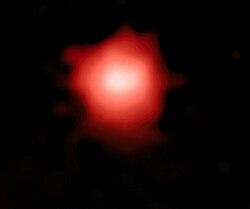Astronomy:GLASS-z12
| GLASS-z12 | |
|---|---|
 Close-up view of GLASS-z12 from the James Webb Space Telescope | |
| Observation data (J2000 epoch) | |
| Constellation | Sculptor |
| Right ascension | 00h 13m 59.76s[1] |
| Declination | −30° 19′ 29.1″[1] |
| Redshift | 12.117±0.012 (spectroscopic)[2] 12.4+0.1 −0.3[1] 12.42+0.27 −0.14[3] 12.28+0.08 −0.07[4] |
| Distance |
|
| Apparent magnitude (V) | 27.0 AB (F200W)[1] |
| Characteristics | |
| Mass | ≈1.0×109 M☉ |
| Size | ~3000 ly (1 kpc) |
| Half-light radius (physical) | 500 pc |
| Other designations | |
| GHZ2[6][7] · GLASS-17487[3] | |
References: [1] | |
GLASS-z12 (formerly known as GLASS-z13) is a Lyman-break galaxy discovered by the Grism Lens-Amplified Survey from Space (GLASS) observing program using the James Webb Space Telescope's NIRCam in July 2022.[8][9] Spectroscopic observations of GLASS-z12 by the Atacama Large Millimeter Array (ALMA) in August 2022 confirmed that the galaxy has a spectroscopic redshift of 12.117±0.012, making it one of the earliest and most distant galaxies ever discovered, dating back to just 350 million years after the Big Bang, 13.6 billion years ago.[10][5] ALMA observations detected an emission line associated with doubly ionized oxygen (O III) at 258.7 GHz with a significance of 5σ, suggesting that there is very low dust content in GLASS-z12, if not the early universe as well.[2] Also based on oxygen-related measurements, the age of the galaxy is confirmed.[11][12]
GLASS-z12 derives its name from the GLASS survey that discovered it and its estimated photometric redshift of approximately z = 12.4+0.1
−0.3.[1] GLASS-z12 was initially announced as GLASS-z13 because it was thought to have a higher redshift of z = 13.1.[7][2] This redshift value was later revised down to z = 12.4 in October 2022, resulting in the renaming of this galaxy.[1]
GLASS-z12 has a light-travel distance (lookback time) of 13.6 billion years.[5] However, due to the expansion of the universe, its present proper distance is 33.2 billion light-years.[5] It was discovered alongside another galaxy, GLASS-z10, comparable to GN-z11, also one of the oldest galaxies discovered.[10]
See also
- CEERS-93316
- Earliest galaxies
- HD1 (galaxy)
- JADES-GS-z13-0
- List of the most distant astronomical objects
- Lyman-break galaxy
References
- ↑ 1.0 1.1 1.2 1.3 1.4 1.5 1.6 Naidu, Rohan P. (November 2022). "Two Remarkably Luminous Galaxy Candidates at z ≈ 10 − 12 Revealed by JWST". The Astrophysical Journal Letters 940 (1): 11. doi:10.3847/2041-8213/ac9b22. L14. Bibcode: 2022ApJ...940L..14N.
- ↑ 2.0 2.1 2.2 Bakx, Tom J. L. C. (2023). "Deep ALMA redshift search of a z ~ 12 GLASS-JWST galaxy candidate". Monthly Notices of the Royal Astronomical Society 519 (4): 5076–5085. doi:10.1093/mnras/stac3723.
- ↑ 3.0 3.1 Donnan, C. T. (November 2022). "The evolution of the galaxy UV luminosity function at redshifts z ≃ 8 - 15 from deep JWST and ground-based near-infrared imaging". Monthly Notices of the Royal Astronomical Society 518 (4): 6011–6040. doi:10.1093/mnras/stac3472. Bibcode: 2023MNRAS.518.6011D.
- ↑ Harikane, Yuichi (2023). "A Comprehensive Study of Galaxies at z ~ 9–16 Found in the Early JWST Data: Ultraviolet Luminosity Functions and Cosmic Star Formation History at the Pre-reionization Epoch". The Astrophysical Journal Supplement Series 265 (1): 5. doi:10.3847/1538-4365/acaaa9. Bibcode: 2023ApJS..265....5H.
- ↑ 5.0 5.1 5.2 5.3 Wright, Edward L. (2022). "Ned Wright's Javascript Cosmology Calculator". University of California, Los Angeles. https://www.astro.ucla.edu/~wright/CosmoCalc.html. Retrieved 24 November 2022. (H0=67.4 and OmegaM=0.315 (see Table/Planck2018 at "Lambda-CDM model" )
- ↑ Castellano, Marco (July 2022). "Early Results from GLASS-JWST. III. Galaxy Candidates at z ~9–15". The Astrophysical Journal Letters 938 (2): L15. doi:10.3847/2041-8213/ac94d0. Bibcode: 2022ApJ...938L..15C.
- ↑ 7.0 7.1 Koren, Marina (22 July 2022). "The Webb Space Telescope Is a Time Machine Observed". The Atlantic. https://www.theatlantic.com/science/archive/2022/07/james-webb-telescope-image-most-distant-galaxy/670616/. Retrieved 22 July 2022.
- ↑ O'Callaghan, Jonathan (20 July 2022). "JWST has found the oldest galaxy we have ever seen in the universe - Discoveries from the James Webb Space Telescope are pouring in, with an analysis of the latest data revealing a galaxy that dates back to just 300 million years after the big bang – the oldest we have ever seen". New Scientist. https://www.newscientist.com/article/2329601-jwst-has-found-the-oldest-galaxy-we-have-ever-seen-in-the-universe/. Retrieved 12 February 2023.
- ↑ O'Callaghan, Jonathan (14 September 2022). "JWST's First Glimpses of Early Galaxies Could Break Cosmology - The James Webb Space Telescope's first images of the distant universe shocked astronomers. Is the discovery of unimaginably distant galaxies a mirage, or a revolution?". Scientific American. https://www.scientificamerican.com/article/jwsts-first-glimpses-of-early-galaxies-could-break-cosmology/. Retrieved 16 September 2022.
- ↑ 10.0 10.1 Adkins, Jamie (17 November 2022). "NASA's Webb Draws Back Curtain on Universe's Early Galaxies". NASA. https://www.nasa.gov/feature/goddard/2022/nasa-s-webb-draws-back-curtain-on-universe-s-early-galaxies. Retrieved 23 November 2022.
- ↑ Staff (25 January 2023). "Astronomers confirm age of most distant galaxy using oxygen". Phys.org. https://phys.org/news/2023-01-astronomers-age-distant-galaxy-oxygen.html. Retrieved 26 January 2023.
- ↑ Bakx, Tom J.L.C. (23 December 2022). "Deep ALMA redshift search of a z ~ 12 GLASS-JWST galaxy candidate". Monthly Notices of the Royal Astronomical Society 519 (4): 5076–5085. doi:10.1093/mnras/stac3723. https://academic.oup.com/mnras/article/519/4/5076/6958810?login=false. Retrieved 26 January 2023.
 |


